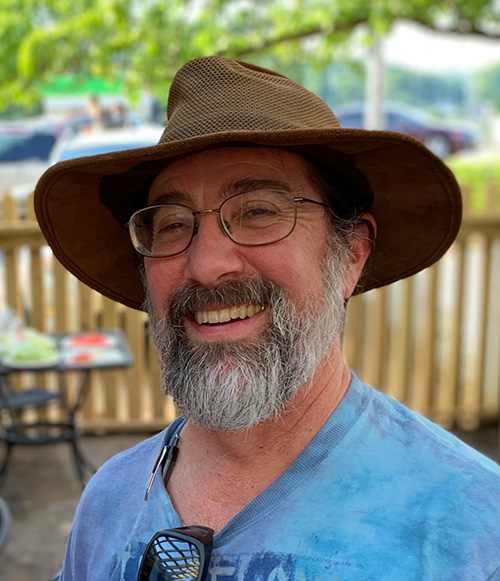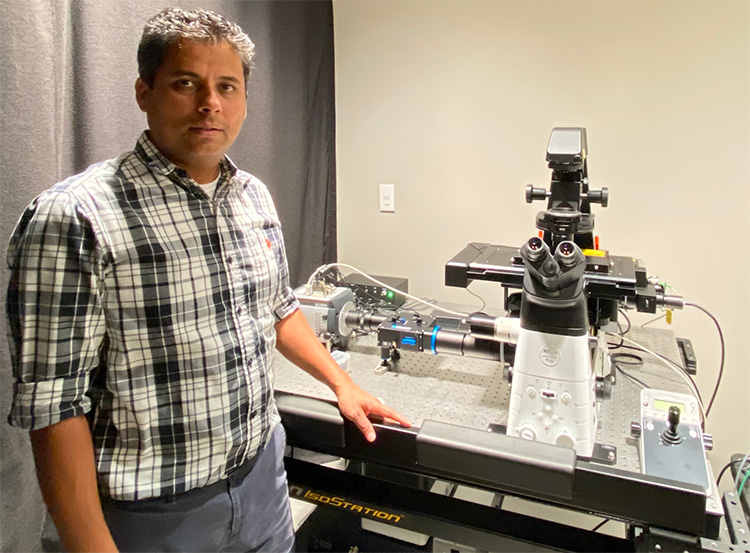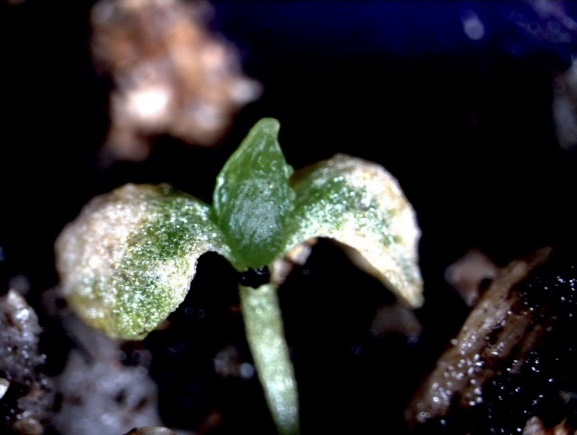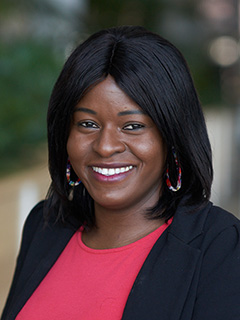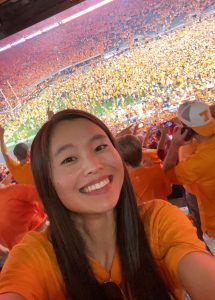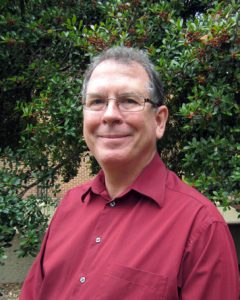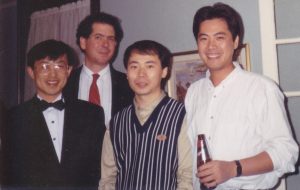Faculty Publications – 2023
- Acharyya D, Cooper J and Prosser RA. Ex vivo comparative investigation of suprachiasmatic nucleus excitotoxic resiliency F1000Research 2023, 11:1242.
- Adhikari A, Khanal S, Magar SR, Thapa S, Khati S, Lamichhane R, Marasini K. (2023) Aspergillus Coinfection in a Hydatid Cyst Cavity of Lung in an Immunocompetent Host: A Case Report and Review of Literature Case Reports in Infectious Diseases https://doi.org/10.1155/2023/6975041.
- Adhikari A, Shrestha S, Bhattarai P, Khanal S, Lamichhane R, Balayar R, Panta S, Marasini K. (2022) Cleidocranial dysplasia—A case report of incidentally found and lately diagnosed disorder Clinical Case Reports 10 (10), e6440.
- Agarwal R and Smith JC. Speed vs accuracy: Effect on ligand pose accuracy of varying box size and exhaustiveness in AutoDock Vina Molecular Informatics 42(3) 2200188 (2023).
- Ancajas CJ, Alam A, Alves DS, Zhou Y, Wadsworth NM, Cassilly CD, Ricks TJ, Carr AJ, Reynolds TB, Barrera BN, Best MD. (2023) Cellular Labeling of Phosphatidylserine Using Clickable Serine Probes. ACS Chemical Biology 18 (2), 377-384.
- Azhar BJ, Abbas S, Aman S, Yamburenko MV, Chen W, Müller L, Jewell DA, Dong J, Shakeel SN, Groth G, Binder BM, Grigoryan G, Schaller GE. (2023) Basis for high-affinity ethylene binding by the ethylene receptor ETR1 of Arabidopsis. Proceedings of the National Academy of Sciences, USA. 120: e2215195120.
- Bogati B, Wadsworth N, Barrera F, Fozo EM. Improved growth of Escherichia coli in aminoglycoside antibiotics by the zor-orz toxin-antitoxin system. Journal of Bacteriology (2022) JB0040721. doi: 10.1128/JB.00407-21 PMID: 34570627.
- Brenya E, Dutta E, Herron B, Walden LH, Roberts DM, and Binder BM. (2023) Ethylene-Mediated Metabolic Priming Increases Photosynthesis and Metabolism to Enhance Plant Growth and Stress Tolerance. PNAS-Nexus doi: 10.1093/pnasnexus/pgad216.
- Brueggeman JM, Windham IA, Nebenführ A (2022) Nuclear movement in growing Arabidopsis root hairs involves both actin filaments and microtubules. Journal of Experimental Botany 73: 5388-5399. DOI: 10.1093/jxb/erac207. PMID: 35554524.
- Das P, San Martin R, McCord RP. Differential contributions of nuclear lamina association and genome compartmentalization to gene regulation. Nucleus. 2023 Dec;14(1):2197693. doi: 10.1080/19491034.2023.2197693. PubMed PMID: 37017584; PubMed Central PMCID: PMC10078145.
- Dockendorff TC, Estrem B, Reed J, Simmons JR, Bahrami Zadegan S, Zagoskin MV, Terta V, Seaberry E, Wang J: The Nematode Oscheius tipulae as A Genetic Model for Programmed DNA Elimination. Current Biology. 2022, 32(23):5083-5098. https://doi.org/10.1016/j.cub.2022.10.043.
- Espinoza-Araya, C., Starbird, R., Prasad, E.S., Venkatesan, R., Mulchandani, A., Bruce, B.D, and Villarreal, C.C., (2023) A bacteriorhodopsin-based biohybrid solar cell using carbon-based electrolyte and cathode components. BBA-Bioenergetics, 1864:4, 148985; https://doi.org/10.1016/j.bbabio.2023.148985.
- Estrem B, Wang J: Programmed DNA elimination in the parasitic nematode Ascaris. PLoS Pathogens. 2023 Feb; 19(2):e1011087. https://doi.org/10.1371/journal.ppat.1011087.
- Ganusova, E.E., Rost, M., Aksenova, A., Abdulhussein, M., Holden, A. and Alexandre, G. 2023. Azospirillum brasilense AerC and Tlp4b Cytoplasmic Chemoreceptors are promiscuous and interact with the two Membrane-Bound Chemotaxis Signaling Clusters mediating chemotaxis responses. J Bacteriol 205(6): e0048422.; doi: 10.1128/jb.00484-22.
- Gao, J., Carnahan, J., Alexandre, G. and Trolinger J. 2022. “Digital holographic microscopy for volumetric, three-dimensional characterization of bacterial motility,” Proc. SPIE 12223, Interferometry XXI, 122230E (3 October 2022); https://doi.org/10.1117/12.2633136.
- Gray ALH, Norman V, Oluwatoba DS, Prosser RA, Do TD. Potential Protective Function of Aβ42 Monomer on Tauopathies. J Am Soc Mass Spectrom. 2023 Mar 1;34(3):472-483.
- Gross LJ, McCord RP, LoRE S, Ganusov VV, Hong T, Strickland WC, Talmy D, von Arnim A, Wiggins G (2023). Enhancing Quantitative and Data Science Education for Graduate Students in Biomedical Science. PloS One. Apr 27;18(4):e0284982. doi: 10.1371/journal.pone.0284982.
- Groves SM, Panchy N, Tyson DR, Harris LA, Quaranta V, Hong T. Involvement of Epithelial-Mesenchymal Transition Genes in Small Cell Lung Cancer Phenotypic Plasticity. Cancers (Basel). 2023 Feb 25;15(5):1477. doi: 10.3390/cancers15051477.
- Gurumoorthy V, Shrestha U, … Smith JC, Petridis L, O’Neill H. Disordered domain shifts the conformational ensemble of the folded regulatory domain of the multidomain oncoprotein c-Src. Biomacromolecules. 24, 2, 714–723 (2023).
- Lee G, Zeng K, Duffy CM, Sriharasha Y, Yoo S, Park JH. 2023. In vivo characterization of the maturation steps of PDF neuropeptide precursor in the Drosophila circadian pacemaker neurons. Genetics, in press. doi: 10.1093/genetics/iyad118
- Li H, McCord RP. Actin up: shifting chromosomes toward repair, but also translocations. Nat Struct Mol Biol. 2023 Jan;30(1):2-4. doi: 10.1038/s41594-022-00906-4. PubMed PMID: 36577921.
- Li J, Xie J …. Smith JC, Hong L. Non-ergodicity of a globular protein extending beyond its functional timescale. Chemical Science. 13 (33), 9668-9677 (2022).
- Liang, L, Wang Y …. Smith JC ….. O’Neill H, Davison BH, Raguskas AJ. Chemical and Morphological Structure of Transgenic Switchgrass Organosolv Lignin Extracted by Ethanol, Tetrahydrofuran, and -Valerolactone Pretreatments. ACS Sustainable Chemistry and Engineering. 10 (28), 9041-9052 (2022).
- Liu J, Willems HME, Sansevere EA, Allert S, Barker KS, Lowes DJ, Dixson AC, Xu Z, Miao J, DeJarnette C, Tournu H, Palmer GE, Richardson JP, Barrera FN, Hube B, Naglik JR, Peters BM. A variant ECE1 allele contributes to reduced pathogenicity of Candida albicans during vulvovaginal candidiasis. PLoS Pathogens (2021) e1009884. doi: 10.1371/journal.ppat.1009884. PMID: 34506615.
- Liu S-H,; Xiao S…. Smith JC ….. Loukas P. Identification of Small-Molecule Inhibitors of Fibroblast Growth Factor 23 Signaling via In Silico Hot Spot Prediction and Molecular Docking to α-Klotho Journal of Chemical Information and Modeling. 62 (15), 3627-3637 (2022).
- Lokdarshi A and von Arnim AG (2023) A Miniature Sucrose Gradient for Polysome Profiling. Bio-protocol 13: e4622. DOI: 10.21769/BioProtoc.4622.
- Lou J, Schuster JA, Barrera FN, Best MD. ATP-Responsive Liposomes via Screening of Lipid Switches Designed to Undergo Conformational Changes upon Binding Phosphorylated Metabolites. J. Amer. Chem. Soc. (2022) ;144(8):3746-3756. PMID: 35171601 DOI: 10.1021/jacs.2c00191.
- Luxem K, Sun JJ, Bradley SP, Krishnan K, Pereira TD, Yttri EA, Zimmermann J, Laubach M. “Open-source tools for behavioral video analysis: Setup, Methods and Development”. eLife, 2023.
- Mamontov E, Bordalla HN … Smith JC, Sokalov AP. Broadband Wide-Angle VElocity Selector (BWAVES) neutron spectrometer designed for the SNS Second Target Station. EPJ Web of Conferences 272 02003 (2022).
- McClintic WT, Scott HL, Moore N, Farahat M, Maxwell M, Schuman CD, Bolmatov D, Barrera FN, Katsaras J, Collier CP. (2023) Heterosynaptic plasticity in biomembrane memristors controlled by pH. MRS bulletin 48 (1), 13-21
- Melchionna M.V., Gullett J.M., Bouveret E., Shrestha H.K., Abraham P.E., Hettich R.L., Alexandre G. 2022. Bacterial Homologs of Progestin and AdipoQ Receptors (PAQRs) Affect Membrane Energetics Homeostasis but Not Fluidity. J. Bacteriol. 204(4):e0058321. doi: 10.1128/jb.00583-21.
- Miller GM, Ellis A …. Smith JC, Lupu DS. Hypothesis‑Agnostic Network‑Based Analysis of Real‑World Data Suggests Ondansetron is Associated with Lower COVID‑19 Any Cause Mortality. Drugs – RealWorldOutcomes 9 (3), 359-375 (2022).
- Mohan M, … Smith JC, Kidder M, Singh S. Accurate Prediction of Carbon Dioxide Capture by Deep Eutectic Solvents using Quantum Chemistry and a Neural Network. Green Chemistry 25(9) 3475 (2023).
- Mohan M, Smith MD …. Smith JC. Predictive understanding of the surface tension and velocity of sound in ionic liquids using machine learning. J. Chem. Phys. 158, 214502 (2023).
- Mohan M, Smith MD …. Smith JC. Quantum Chemistry-Driven Machine Learning Approach for the Prediction of the Surface Tension and Speed of Sound of Ionic Liquids. ACS Sustainable Chem. Eng. 2023, 11, 20, 7809–7821
- Mongès A, Yaakoub H, Bidon B, Glévarec G, Héricourt F, Carpin S, Chauderon L, Drašarová L, Spichal L, Binder BM, Papon N, Rochange S. (In press) Are histidine kinases of arbuscular mycorrhizal fungi involved in the response to ethylene and cytokinins? Molecular Plant-Microbe Interactions
- Mykins M, Layo-Carris D, Dunn L, Skinner DW, Perez S, McBryar A, Shultz TR, Willems A, Lau BYB, Hong T, Krishnan K. “Wild-type MECP2 expression coincides with age-dependent sensory deficits in a female mouse model for Rett syndrome”. Journal of Neuroscience Research, 2023.
- Mykins M, Marrero K, Cataldo G, Aruljothi K, Krishnan K, Brumberg J. “Barrels XXXV: Barrels In-Person”. Somatosensory & Motor Research, 2023.
- Nordick B, Chae-Yeon Park M, Quaranta V, Hong T. Cooperative RNA degradation stabilizes intermediate epithelial-mesenchymal states and supports a phenotypic continuum. iScience. 2022 Sep 27;25(10):105224. doi: 10.1016/j.isci.2022.105224.
- Panchy N, Watanabe K, Takahashi M, Willems A, Hong T. Comparative single-cell transcriptomes of dose and time dependent epithelial-mesenchymal spectrums. NAR Genom. Bioinform. 2022 Sep 21;4(3):lqac072. doi: 10.1093/nargab/lqac072.
- Park HL, Seo DH, Lee HL, Bakshi A, Park C, Chien Y-C, Kieber JJ, Binder BM, Yoon GM (2023) Ethylene-triggered subcellular trafficking of CTR1 enhances the response to ethylene gas. Nature Communications 124: 365. doi: 10.1038/s41467-023-35975-6.
- Rajeshwart T & Smith JC. Structural Patterns in Class 1 Major Histocompatability Complex-restricted Nonamer Peptide Binding to T-cell Receptors. Proteins: Structure, Function and Bioinformatics. 90(9):1645-1654 (2022).
- Roger D, Agarwal R, …. Glaser J, Smith JC. SARS-CoV2 Billion-Compound Docking. Nature Scientific Data. 10(1)173 (2023).
- Russell CM, Rybak JA, Miao J, Peters BM, Barrera FN. (2022) The Candida albicans virulence factor candidalysin polymerizes in solution to form membrane pores and damage epithelial cells. Elife 11, e75490.
- Russell CM, Rybak JA, Miao J, Peters BM, Barrera FN. (2022) Candidalysin: connecting the pore forming mechanism of this virulence factor to its immunostimulatory properties. Journal of Biological Chemistry, 102829.
- Rybak JA, Sahoo AR, Kim S, Pyron RJ, Pitts SB, Guleryuz S, Smith AW, Buck M, Barrera FN. (2023) Allosteric inhibition of the epidermal growth factor receptor through disruption of transmembrane interactions. Journal of Biological Chemistry, https://doi.org/10.1016/j.jbc.2023.104914.
- San Martin R, Das P, Sanders JT, Hill AM, McCord RP. Transcriptional profiling of Hutchinson-Gilford Progeria syndrome fibroblasts reveals deficits in mesenchymal stem cell commitment to differentiation related to early events in endochondral ossification. Elife. 2022 Dec 29;11. doi: 10.7554/eLife.81290. PubMed PMID: 36579892.
- Schaefer KG, Pittman AE, Barrera FN, King GM. “Atomic force microscopy for quantitative understanding of peptide-induced lipid bilayer remodeling”. Methods (2022) 197:20-29. doi: 10.1016/j.ymeth.2020.10.014.
- Shelby SA, Castello-Serrano I, Wisser KC, Levental I, Veatch SL. Membrane phase separation drives responsive assembly of receptor signaling domains. Nat Chem Biol. 2023 Jun;19(6):750-758. doi: 10.1038/s41589-023-01268-8. Epub 2023 Mar 30.
- Shelby SA, Shaw TR, Veatch SL. Measuring the Co-Localization and Dynamics of Mobile Proteins in Live Cells Undergoing Signaling Responses. Methods Mol Biol. 2023;2654:1-23. doi: 10.1007/978-1-0716-3135-5_1.
- Shelby SA, Veatch SL. The Membrane Phase Transition Gives Rise to Responsive Plasma Membrane Structure and Function. Cold Spring Harb Perspect Biol. 2023 Aug 8:a041395. doi: 10.1101/cshperspect.a041395.
- Shen S, Parks JM, Smith JC. HCLus: HLA Class I Supertype Classification. BMC Bioinformatics. 24(1) 1-13 (2023).
- Shen S, Parks JM, Smith JC. HLA Class I Supertype Classification Based on Structural Similarity. Journal of Immunology. 210(1) 103-114 (2023).
- Sobe R.C., Gilbert C., Vo, L. Alexandre G. and Scharf, B. E. 2022. FliL and its paralog MotF have distinct roles in the stator activity of the Sinorhizobium meliloti flagellar motor. Mol Microbiol 118(3):223-243. doi:10.1111/mmi.14964.
- Tan L, Scott H, … Smith JC, Davison J, Elkins J, Nickels J. Amphiphilic co-solvents modulate structure of membrane domains. ACS Sustainable Chemistry & Engineering. 11 4 1598-1609 (2023).
- Tan L, Smith MD, Scott H …. Smith JC, Davison BH, Nickels JD. Modeling the partitioning of amphiphilic molecules and co-solvents in biomembranes. Journal of Applied Crystallography. 55(6), 1401-1412 (2022).
- Taylor MK, Williams EP, …. Smith JC, Jonsson CBB. Dissecting Phenotype from Genotype with Clinical Isolates of SARS-CoV-2 First Wave Variants. Viruses. 15(3) 611(2023).
- Veatch SL, Rogers N, Decker A, Shelby SA. The plasma membrane as an adaptable fluid mosaic. Biochim Biophys Acta Biomembr. 2023 Mar;1865(3):184114. doi: 10.1016/j.bbamem.2022.184114. Epub 2022 Dec 26.
- Voloshin R.A., Bozieva A.M., Bruce B.D., and Allakhverdiev S.I. (2023) Photosynthetic microbial fuel cells: practical applications of electron transfer chains. Russian Chem. Reviews, 92:5, 5073; https://doi.org/10.57634/RCR5073.
- Willems A, Panchy N, Hong T. Using Single-Cell RNA Sequencing and MicroRNA Targeting Data to Improve Colorectal Cancer Survival Prediction. Cells. 2023 Jan 5;12(2):228. doi: 10.3390/cells12020228.
- Workman, C.E., Cawthon, C., Brady, N.G., Bruce, B.D., and Long, B., (2022) Degradation of Esterified Styrene-Maleic Acid Copolymers. Biomacromolecules 23, 11, 4749–4755109; https://doi.org/10.1021/acs.biomac.2c00928.
- Xu Y, Kramann R, McCord RP, Hayat S. MASI enables fast model-free standardization and integration of single-cell transcriptomics data. Commun Biol. 6, 465 (2023). doi: 10.1038/s42003-023-04820-3.
- Yao T, Zhang J … Binder BM, …. Chen J-G, Muchero W. (In press) eQTL mapping identified PtrXB38 as a key hub gene in adventitious root development in Populus. New Phytologist.
- Zharmukhamedov, S.K., Shabanova, M.S., Huseynova, I.M., Karacan, M.S., Karacan, N., Akar, H., Kreslavski, V.D., Alharby, H.F., Bruce, B.D., and Allakhverdiev, S.I. (2023) Probing the influence of novel organometallic copper (II) complexes on spinach PSII photochemistry using OJIP fluorescence transient measurements. Biomolecules 13(7), 1058; https://doi.org/10.3390/biom13071058.
- Zhou, Y., Syed, J., Semchonok, D.A., Kyrilis, F.L., Hamdi, F., Kastrittis, P.L., Wright, E., Bruce, B.D., and Reynolds, T.B. (2023) Solubilization, purification and characterization of the hexameric form of phosphatidylserine synthase from Candida albicans. J. Biol. Chem., 299:6,104756; https://doi.org/10.1016/j.jbc.2023.104756.

